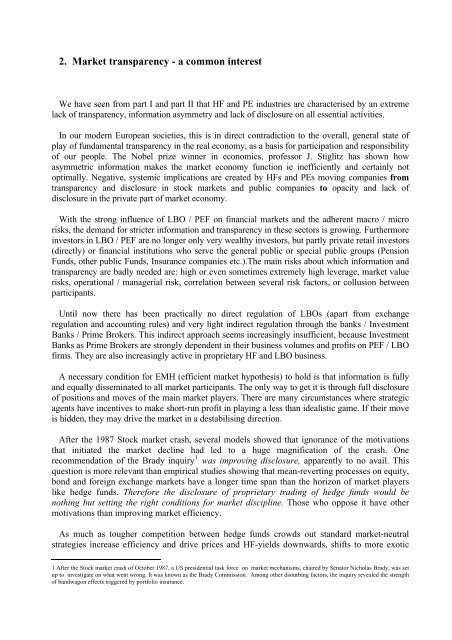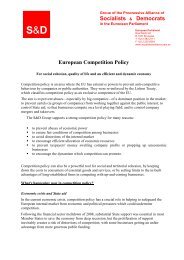Executive summary - Udo Bullmann
Executive summary - Udo Bullmann
Executive summary - Udo Bullmann
- No tags were found...
Create successful ePaper yourself
Turn your PDF publications into a flip-book with our unique Google optimized e-Paper software.
2. Market transparency - a common interestWe have seen from part I and part II that HF and PE industries are characterised by an extremelack of transparency, information asymmetry and lack of disclosure on all essential activities.In our modern European societies, this is in direct contradiction to the overall, general state ofplay of fundamental transparency in the real economy, as a basis for participation and responsibilityof our people. The Nobel prize winner in economics, professor J. Stiglitz has shown howasymmetric information makes the market economy function ie inefficiently and certainly notoptimally. Negative, systemic implications are created by HFs and PEs moving companies fromtransparency and disclosure in stock markets and public companies to opacity and lack ofdisclosure in the private part of market economy.With the strong influence of LBO / PEF on financial markets and the adherent macro / microrisks, the demand for stricter information and transparency in these sectors is growing. Furthermoreinvestors in LBO / PEF are no longer only very wealthy investors, but partly private retail investors(directly) or financial institutions who serve the general public or special public groups (PensionFunds, other public Funds, Insurance companies etc.).The main risks about which information andtransparency are badly needed are: high or even sometimes extremely high leverage, market valuerisks, operational / managerial risk, correlation between several risk factors, or collusion betweenparticipants.Until now there has been practically no direct regulation of LBOs (apart from exchangeregulation and accounting rules) and very light indirect regulation through the banks / InvestmentBanks / Prime Brokers. This indirect approach seems increasingly insufficient, because InvestmentBanks as Prime Brokers are strongly dependent in their business volumes and profits on PEF / LBOfirms. They are also increasingly active in proprietary HF and LBO business.A necessary condition for EMH (efficient market hypothesis) to hold is that information is fullyand equally disseminated to all market participants. The only way to get it is through full disclosureof positions and moves of the main market players. There are many circumstances where strategicagents have incentives to make short-run profit in playing a less than idealistic game. If their moveis hidden, they may drive the market in a destabilising direction.After the 1987 Stock market crash, several models showed that ignorance of the motivationsthat initiated the market decline had led to a huge magnification of the crash. Onerecommendation of the Brady inquiry 1 was improving disclosure, apparently to no avail. Thisquestion is more relevant than empirical studies showing that mean-reverting processes on equity,bond and foreign exchange markets have a longer time span than the horizon of market playerslike hedge funds. Therefore the disclosure of proprietary trading of hedge funds would benothing but setting the right conditions for market discipline. Those who oppose it have othermotivations than improving market efficiency.As much as tougher competition between hedge funds crowds out standard market-neutralstrategies increase efficiency and drive prices and HF-yields downwards, shifts to more exotic1 After the Stock market crash of October 1987, a US presidential task force on market mechanisms, chaired by Senator Nicholas Brady, was setup to investigate on what went wrong. It was known as the Brady Commission. Among other disturbing factors, the inquiry revealed the strengthof bandwagon effects triggered by portfolio insurance.





